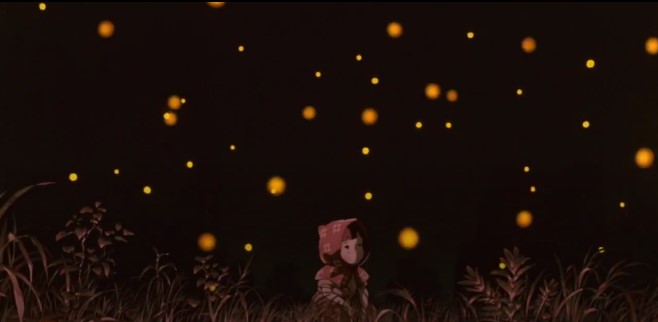A graveyard: autumn fireflies, two or three
Gensho, 1742
In this two-part blog post, I will use the story structure of Hotaru no Haka (Grave of the Fireflies, Isao Takahata, 1988) to highlight how in the two identifiable story timelines of this feature film Carl Plantinga’s concept of the spillover effect can be identified, even if it is employed in peculiar ways.
The Spillover Effect and the Ritual of Commemoration. Carl R. Plantinga (see 2009, 169-197) asks the question: “Why do audiences subject themselves to the representation of traumatic events?”. He argues that there must be a restored balance between positive and negative emotions — an affective compensation as he calls it — for the cinematic experience to be enjoyable, and finds this balance in the ritual of commemoration. Plantinga uses the ending of Titanic (James Cameron, 1997) to illustrate this phenomenon. The negative feelings at the moment of Jack’s death are transformed into positive ones through Rose giving the diamond to the ocean. A renovated sense of meaning has been created. The negative emotions leave a physiological residue, which overflows onto positive emotions by the end of the film. This is the spillover effect. And it can be found in Hotaru no Haka as well, as will be demonstrated in the following sections.
Hotaru no Haka (Grave of the Fireflies). Twenty-two years after witnessing the death of his sister Keiko due to malnutrition, in an attempt to purge his sense of guilt, writer Akiyuki Nosaka published the semi-autobiographical short story Hotaru no Haka (Grave of the Fireflies) as an apology for her departure. In 1988, Isao Takahata, the co-founder of Studio Ghibli, directed an animated neorealist rendition of this short story (see Violet 2018), which narrates the tale of Seita and Setsuko, and their attempt to survive as orphans during the last months of World War II. Setsuko, a four-year-old girl, will die of malnutrition, and her thirteen-year-old brother, Seita, will burn her body and collect her bones in an empty tin of candy, Sakuma Drops, before passing away shortly after.
Two distinct timelines can be identified in this film. One is the main timeline, chronologically structured for the audience to understand the sequence and causality of events. The second one will be referred to as “the spirit timeline”, which is argued to have a distinct function. Aside from a slight variance in color tones, two major differences set them apart:
- The presence of Seita or Setsuko’s ghost (if not both). This nuance is confirmed by critic Roger Ebert (2000) who, talking about the film structure, states that “we are accompanied through flashbacks by the boy’s spirit.”
- The leitmotif of fireflies guides us from one timeline to the other with a soft touch conceptually similar to Ozu’s pillow shots.
Both timelines are depicted in a similar fashion and seem to merge into a single one. It is only through an attentive analysis of the narrative structure that we can notice their subtle differences.
A Circular Type of Narrative Structure. Medium shot of Seita in a clean school uniform and an off-white Captain’s hat, directly staring at the audience. “September 21, 1945,” he whispers. “That was the night I died.” All the while his lips do not move. Reverse chronology is applied and we learn that the opening scene is temporally located at the end of the plot. The scene cuts to an empty room where the starving figure of Seita slowly appears, lying on the ground. His ghost, the narrator, stares at his own dying body. “Setsuko…” he whispers. A janitor approaches and pokes him with a broom. “Another one,” he scoffs, inspecting him. Something falls rattling on the ground: a tin of Sakuma Drops, the remains of Setsuko. The air is filled with the starving sighs of several men — the station is where they go to die. The janitor stops in front of an open door. Mimicking a baseball throw, he pitches the tin in the air. It lands in the grass. Tiny fragments of bones fall out, and a non-diegetic melody starts playing — fireflies soar up to the sky from the soil (see Fig. 1).
Cut to Setsuko’s ghost playing in a field at night, surrounded by the same fireflies (see Fig. 2). Inside the open door is the dying body of Seita. Concerned, she moves towards him, but a hand grabs her by the shoulder. It is Seita, still in a uniform, nodding and smiling at her. “Don’t worry,” his glance implies. They walk away from the screen, hand in hand.
There is no spillover effect in this scene, but it is a useful example of how the difference between timelines is set. While Seita dies in the first ten minutes of the film, his ghost appears in the spirit timeline, ready to tell his story. Additionally, we are introduced to the character of Setsuko in the form of a ghost. It becomes clear to the audience that the spirit timeline functions without chronology.
A sense of hopelessness is created — but there is no release, nor a sense of meaning. The spirit timeline provides a sequence of the two siblings being together and happy, but this appearance is placed too soon within the film to be seen as a resolution or as a means of transformation of negative emotions. This sequence belongs to the end of their story, we just don’t know it yet.
References
Ebert, Roger (2000), “Grave of the Fireflies”, RogerEbert.com, https://www.rogerebert.com/reviews/great-movie-grave-of-the-fireflies-1988 (Accessed April 10, 2022)
Lucca, Violet. 2018. “Worldly Wise”. Film Comment. https://www.filmcomment.com/article/worldly-wise/ (Accessed April 10, 2021)
Plantinga, Carl R. (2009) Moving Viewers, Berkeley: Californa University Press.
Gaia Kriscak is a MA student at the Department of Film and Screen Media at UCC, Ireland. She is interested in the function and the portrayal of props and domestic space in world cinema.


